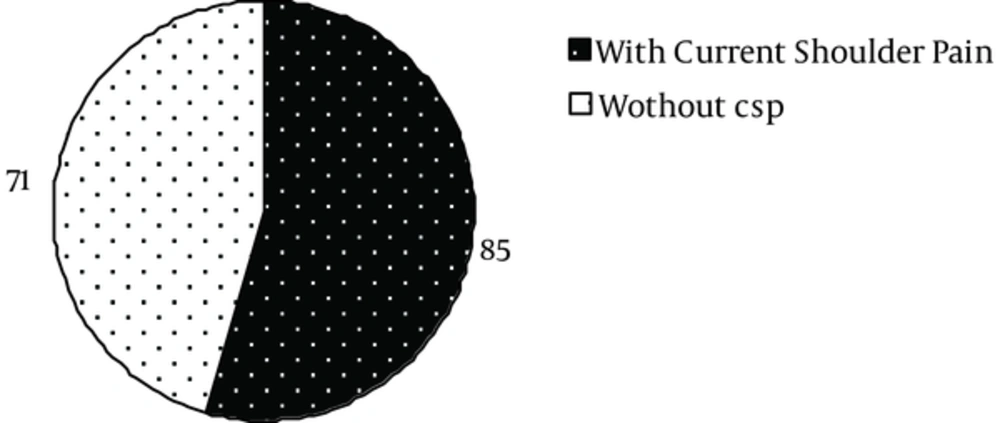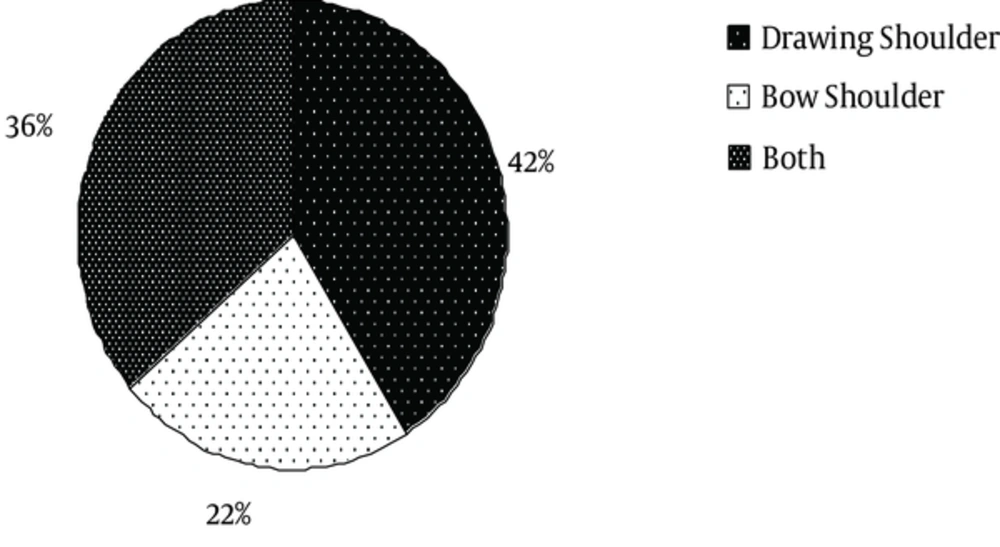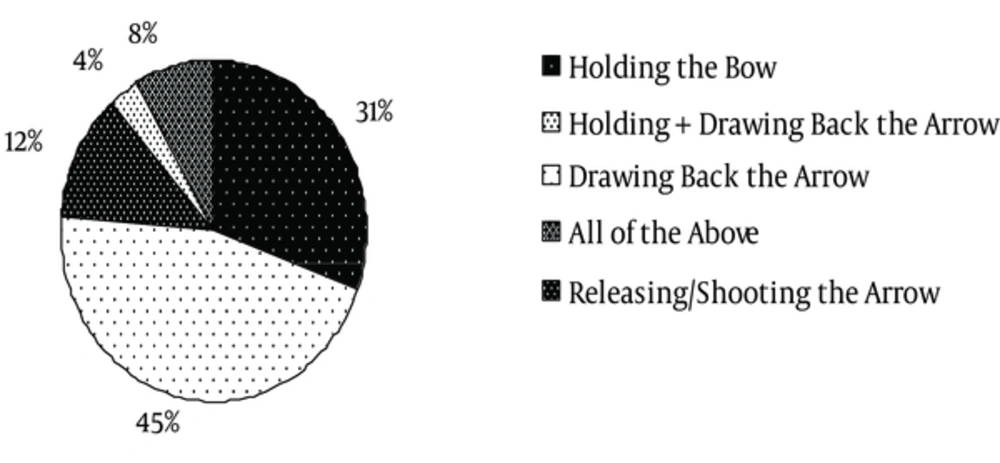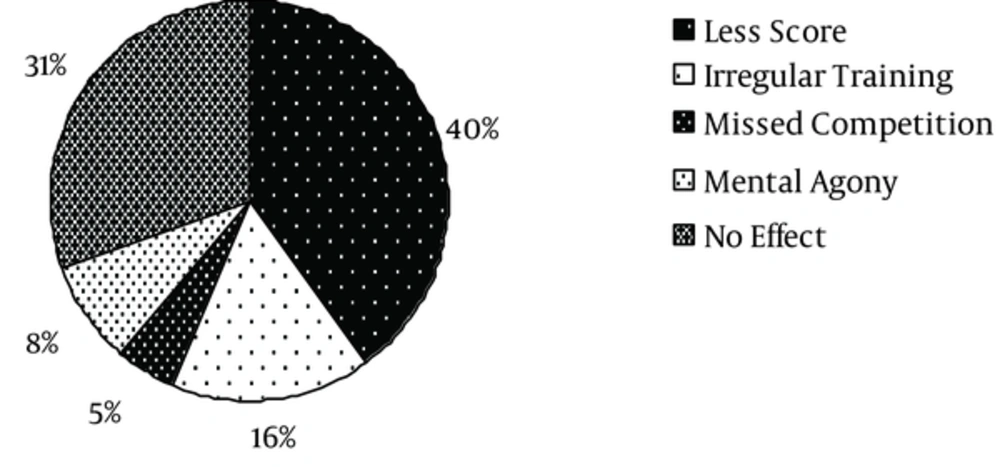1. Background
Prevalence of shoulder pain in sports that require repetitive overhead use of arm is quite high (1). Application of high energy force in a repetitive manner predisposes the static and dynamic stabilizers of shoulder joint to chronic injuries and attenuation following which a mild instability pattern develops that places increased demand on rotator cuff muscles (2). Fatigue of rotator cuff associated with increased workload allows anterosuperior humeral head translation and secondary impingement of the subacromial structures (3). High Prevalence of shoulder overuse injuries is reported in swimming (4, 5), tennis (6) and other overhead sports such as badminton (7) volleyball (8) and handball (9).
Shoulder pain in competitive archery is not well studied; though it is perceived as a common condition (10). Competitive archery involves shooting arrows at a target from set distances. The repetitive movement of drawing and releasing the bow places asymmetric forces on the structure of shoulder girdle (11) and has been implicated as the causative mechanism for archery related shoulder injuries (12). Repetitive concentric and eccentric loading of the muscles of shoulder girdle and upper back during draw and stance may cause fatigue and tendinitis of the surrounding muscles (13). Available studies (12, 14-16) reported the prevalence of shoulder pain in archery ranging from 7 % (12) to 62.5% (16). Nonetheless the epidemiologic data on archery related injuries are scarce (10). The purpose of this study was to document the features of shoulder injuries and determine the prevalence of shoulder pain in Indian competitive archers.
2. Methods
Study design of this cross sectional survey was approved by institutional ethical committee of Punjabi University Patiala as per the protocol of Indian council of medical research. The sample consisted of 156 archers (M = 91, F = 65) participating in all India inter university archery champion 2013, mean age = 20.27 ± 2.31 (range 15 - 28 years). Regular training and participation in the game for at least one year prior to survey was the criteria of inclusion. Players below 16 years of age were excluded. Mean year of participation was 4.33 ± 2.57 (range 1 - 12 years). Subjects were informed about the purpose of study and their written consent to participate in the survey was obtained. The survey was conducted during the All India Inter University Archery Tournament held at Amritsar, Punjab during February 2013. The data was collected through schedule interview and clinical examination of both the shoulders.
2.1. Schedule Interview
After an extensive review of literature and interaction with coaches, a schedule of questions was developed to interview the subject. Pilot testing of the schedule was conducted on 40 archers one month prior to survey. The interview schedule consisted of 76 questions focusing on demographics, training profile, current and past shoulder pain, treatment history and impact of injury on performance. “Yes” response to questions “are/ were you feeling pain in the shoulder” were considered to level an archer as afflicted with current/past shoulder pain.
2.2. Clinical Examination
Clinical examination consisted of inspection of both the shoulders for any visible atrophy and asymmetry around shoulder and scapula. Palpation was performed for crepitation and tenderness over greater tuberosity, bicipital groove, acromioclavicular junction, trapezius muscle, cervical spinous processes and paraspinal muscles. A special tests battery for shoulder included Neer’s test, Hawkins- Kennedy test for shoulder impingement, apprehension relocation test for anterior instability, sulcus sign for inferior instability, painful arc, Speed’s test for long head of biceps, lift off test for subscapularis involvement (17) and resisted isometric contraction of supraspinatus (18).
2.3. Statistical Analysis
Archers were categorized in two groups - those with current shoulder pain (CSP) and those without current shoulder pain. Mean, standard deviation and percentage were used to prepare summary statistics. Odds ratio, cross tabulation with chi square (χ2) test and t test were used for determining the group differences and detecting association.
3. Results
3.1. Prevalence
54.4 % (n = 85) archers were found afflicted with current shoulder pain (CSP) at the time of survey (Figure 1). The lifetime prevalence of shoulder pain was 82.69% with 44 archers without CSP and 67 archers with CSP reported having at least one episode of shoulder pain in the past.
3.2. Clinical Findings of Archers with CSP
The majority (41.18%) had Pain in the drawing shoulder (Figure 2). The activity most frequently (45.88%) associated with pain was drawing back the bow (Figure 3). 80 % felt pain only during specific activities that disappeared between sessions. Shoulder pain did not disappear between sessions in 20% of archers and interfered with execution of sporting activity (Figure 4).
Positive Hawkins-Kennedy Test, positive Speed’s test, positive lift off test, painful isometric contraction of supraspinatus, positive Neer’s test, Positive apprehension-relocation test, and tenderness on trapezius muscle were the most common clinical signs observed in more than 40 % archers with CSP. Positive Hawkins test was significantly associated (P < 0.05) with positive Neer’s test (OR = 9.38), Speed’s test (OR = 11.05), lift off test (OR = 8.68) and isometric contraction of supraspinatus (OR = 6.98).
3.3. Clinical Findings of Archers Without CSP
Positive Hawkins test and apprehension relocation tests were present in 38.02% and 11.26% respectively of those who did not admit having current shoulder pain. Some of them also demonstrated positive speeds test, lift off test and painful isometric contraction of supraspinatus (Table 1).
| Findings | With CSP( n = 85) | Without CSP ( n = 71) | Total (n = 156) |
|---|---|---|---|
| Tenderness on greater tuberosity | 9 (10.58) | 5 (07.04) | 14 (8.97) |
| Tenderness on bicipital groove | 15 (17.64) | 1 (01.40) | 16 (10.25) |
| Tenderness on acromioclavicular junction | 2 (2.35) | 2 (02.81) | 4 (2.56) |
| Tenderness on cervical spinous process | 7 (08.23) | 4 (05.63) | 11 (7.05) |
| Tenderness on trapezius muscle | 34 (40.00) | 9 (12.67) | 42 (26.92) |
| Tenderness on paraspinal Muscles | 9 (10.58) | 2 (2.81) | 11 (7.05) |
| Positive Neer’s test | 38 (44.7) | 10 (14.08) | 48 (30.76) |
| Positive Hawkins’s-Kennedy test | 68 (80.00) | 27 (38.02) | 95 (60.89) |
| Painful arc | 12 (14.11) | 4 (05.63) | 16 (10.25) |
| Positive relocation test | 36 (42.35) | 8 (11.26) | 44 (28.20) |
| Positive sulcus sign | - | - | - |
| Positive Speed’s test | 51 (60.00) | 23 (32.39) | 74 (47.43) |
| Positive lift off test | 44 (51.76) | 11 (15.49) | 55 (35.25) |
| Painful isometric contraction of supraspinatus | 44 (51.76) | 8 (11.26) | 52 ( 33.33) |
Clinical Findings of Archers with and Without CSPa
3.4. Impact of Current Shoulder Pain
8.25% of archers with CSP were unable to play. 40% of archers with CSP perceived that shoulder pain was interfering with their ability to achieve a higher score (Figure 5).
3.5. Risk Factors
The Occurrence of current shoulder pain was significantly associated with past shoulder pain (OR = 2.57) and old age (OR = 2.13) (Table 2) but not with any extrinsic risk factor (Table 3). Gender and treatment of previous shoulder pain was not associated with current shoulder pain.
| Risk Factors | With CSP (n = 85) | Without CSP (n = 71) | χ / t-test |
|---|---|---|---|
| Lack of warm up | 14 (16.47) | 8 (11.26) | 0.86 |
| Lack of cool down | 22 (25.88) | 12 (16.90) | 01.8 |
| No gym work for shoulder strengthening | 71 (83.52) | 62 (87.32) | 01.49 |
| Participation in other overhead game | 18 (21.17) | 13 (18.30) | 0.59 |
| Lack of stretching | 13 (15.29) | 05 (7.04) | 02.58 |
| Average number of arrows shot during single practice day | 145.22 ± 94.35 | 143.50 ± 124.98 | 0.09 |
| Monthly training hours | 131.40 ± 67.81 | 139.59 ± 67.71 | 0.75 |
| Yearly training hours | 1104.84 ± 689.46 | 1131.12 ± 676.85 | 0.75 |
| Years spend in the game, y | 0.10 | ||
| > 5 | 22 (25.88) | 20 (28.16) | |
| ≤ 5 | 63 (74.11) | 51 (71.83) | |
| Type of bow | 1.69 | ||
| Compound | 24 (28.23) | 16 (22.53) | |
| Recurve | 22 (23.52) | 15 (21.12) | |
| Wooden | 39 (48.25) | 40 (56.33) |
Extrinsic Factors Associated with Current Shoulder Paina
4. Discussion
Competitive archery is considered as a safe game with fewer occurrences of injuries. However the finding of this study indicates that shoulder pain is a significant problem among Indian competitive archers: the point prevalence was 54.48% whereas the life time prevalence was 82.69%. For 64.74% of archers, shoulder pain was a recurrent phenomenon.
Prevalence of shoulder injury in competitive archery is not widely reported, though the available studies (12, 14-16) do recognized the shoulder as one of the most commonly injured body parts in this sport. A case control study of Mann and Littke (14) was probably the first work that recognized shoulder impingent as a substantial problem in archers. Using a retrospective questionnaire and physical examination they reported that 50% elite archers (11 out of 22) had complained of significant shoulder injuries either currently or during their careers. In subsequent reports Renfro observed that out of 33 injuries recorded over a 10-month period 48.5% were confined to the shoulder. Chen (16) in a survey of 24 elite archers observed that the shoulder and the wrist were the most commonly injured body parts with 62.5% archers reporting an injury to each of these areas. Ertan (12) opined that drawing arm shoulder injuries were the second most pervasive injury type among archers but in their survey of 88 archers during Turkish Archery Championship only 7% of archers reported sustaining shoulder injuries in the preceding two years.
The present study- probably the first on Indian competitive archers- confirms that shoulder pain is quite a common occurrence in archery. The strength of the study is its cohort size and methodology used in the survey. Unlike the retrospective questionnaire used in the survey of Ertan (12) present study used schedule interview technique supplemented by structured clinical examination to gather information. All the subjects were personally interviewed and examined by a physiotherapist specializing in sports medicine. In comparison to the questionnaire, the information gathered through schedule interview is relatively more accurate as it eliminates the chance of collecting incomplete information due to wrong interpretation and non-response of questions (19). The only study that used similar methodology was that of Mann and Likart (14), but their sample was confined to 22 archers. Comparatively a larger sample size was used in this study that was conducted during a major national archery event which may in part account for higher prevalence of shoulder injuries observed in this study.
The clinical findings of this study suggest predominance of shoulder impingement in the game of archery. 60.89% archers had positive Hawkins tests of impingement; out of which 71.57% had current shoulder pain. Presence of tenderness over greater tuberosity and bicipital groove, and significant association of positive Hawkins- Kennedy test with Speed’s test, lift off test and painful resisted isometric supraspinatus contraction indicate the involvement of the long head of biceps, subscapularis and supraspinatus possibly due to impingement. Significant association of the occurrence of shoulder pain with positive apprehension relocation test observed in this study suggests that anterior instability may also have role in the development of shoulder problems in archers.
The shooting action of archery does not involve overhead activity. But it does place tremendous stress on the shoulder in the extreme of horizontal abduction and extension (20). Further repetitive stresses of the stance of archer may create recurrent shoulder instability (11, 14, 15, 21). The development of impingement and tendinitis of rotator cuff muscles observed in this study might be attributed to these mechanisms.
Ability to hold arm and bow in steady position for several seconds during aiming and release phase of shooting is critical for performance and it requires significant activity of rotator cuff muscles. It is reasonable to assume that pain inhibition of rotator cuff muscles might have affected the stance and release technique leading to poor performance reflected as low scoring. However occurrence of shoulder pain was not taken seriously by the archers because for the majority, the pain was activity related and disappeared between sessions. Many archers did not admit having shoulder pain though they had positive clinical signs. Players ignoring the shoulder pain and continuing with the game has been observed in other games (7, 9) as well. 21.11 % archers experienced the constant pain and most of them had experienced previous episodes of shoulder pain.
This observation has important implications for the coaches and sports medicine service providers. Overuse injuries develop gradually over the time and once established take longer time to heal. Players often do not appreciate the consequence of these injuries in the initial stage. It is important that archers be educated about the signs and symptoms of overuse tendinitis as most of these injuries may be halted in the initial stage by modification of activity and training schedule.
Data on the extrinsic and intrinsic risk factors of archery injuries are not available; though training duration, technique, bow weight, number of arrows fired in a session, number of years spent in the game, age, and sex are implicated as the risk factors for archery injuries (14, 22, 23). Ertan (12) has reported an association between hours practiced, arrows fired and injury patterns. In the present study warm up or cool down practices, participation in other overhead games, shoulder strengthening, the type of bow and year spent in the game were not associated with the occurrence of current shoulder Pain. The monthly and yearly training hours and the number of arrows shot per session of archers with CSP were also not significantly different from those without CSP.
The intrinsic factors significantly associated with occurrence of current shoulder pain were age of the player and history of previous shoulder pain. Shoulder pain was more prevalent in older Archers (> 20 years) as compared to the younger age group (< 20 years). Increased exposure to the game and accumulation of the effect of micro injuries may account for increased occurrence of overuse injuries with advancing age (24).
Mann and Littke (14) reported that the female archers had proportionally more signs and symptoms of shoulder injury than men. However in the present study, shoulder pain affected male and female archers in equal proportion and gender was not associated with occurrence of shoulder pain.
The limitations of this study include one time examination of shoulder and use of retrospective questionnaire for collecting information about past injury and training events. There is an urgent need to cross validate the finding of this study using prospective design.
In conclusion, this study highlights that shoulder pain is quite prevalent among Indian competitive archers. Most of the injuries were overuse in nature affecting the supraspinatus, long head of biceps and subscapularis muscle due to impingement. Many archers did not admit having shoulder pain despite being tested positive in clinical tests. It is imperative that periodic screening of archers is made part of training so that the occurrence of injury can be timely detected. The presence of a qualified sports physiotherapist during training would ensure early identification of archers at risk of injury and delivery of a comprehensive treatment and appropriate prevention strategies to injured archers.




